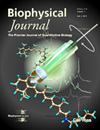动态微管作为动物细胞的传感器。
IF 3.1
3区 生物学
Q2 BIOPHYSICS
引用次数: 0
摘要
微管作为结构元件和极化运输路径,在物理上组织真核细胞。本文在高等植物细胞的基础上,提出了动态微管也可以作为细胞形状和细胞质状态的传感器的假设。微管聚合动力学和晶格结构对机械、化学和信号输入敏感,这些输入改变了微管和可溶性微管蛋白之间的平衡,并调节了MAP的结合亲和力。这些变化是通过包括GTP交换因子GEF-H1 (ARHGEF2)和MARK家族激酶在内的传感器检测到的。由此产生的信号调节细胞质行为、基因表达和组织生理。微管不稳定药物秋水仙碱和普林布林可能模仿微管对病理生理信号的感知,导致激活基因表达程序,促进细胞存活、生长和修复,这说明了药物的治疗作用。在形态稳定的组织细胞中,微管的感觉功能可能与它们的结构功能一样重要,甚至更重要。这种微管生物学的重新构建为机制研究和药物发现提供了新的方向。本文章由计算机程序翻译,如有差异,请以英文原文为准。
Dynamic Microtubules as Sensors in Animal Cells.
Microtubules physically organize eukaryotic cells by serving as structural elements and polarized transport tracks. This article advances the hypothesis that dynamic microtubules also serve as sensors of cell shape and cytoplasmic state, building on ideas proposed for higher plant cells1. Microtubule polymerization dynamics and lattice structure are sensitive to mechanical, chemical and signaling inputs which alter the balance between microtubules and soluble tubulin and regulate MAP binding affinity. These changes are detected by transducers which include the GTP exchange factor GEF-H1 (ARHGEF2) and MARK family kinases. The resulting signals regulate cytoplasmic behavior, gene expression and tissue physiology. The microtubule destabilizing drugs colchicine and plinabulin may mimic sensing of pathophysiological cues by microtubules, leading to activation gene expression programs that promote cell survival, growth and repair which account for the therapeutic actions of the drugs. In tissue cells with stable morphologies, the sensory functions of microtubules may be as or more important than their architectural functions. This re-framing of microtubule biology suggests new directions for mechanistic inquiry and drug discovery.
求助全文
通过发布文献求助,成功后即可免费获取论文全文。
去求助
来源期刊

Biophysical journal
生物-生物物理
CiteScore
6.10
自引率
5.90%
发文量
3090
审稿时长
2 months
期刊介绍:
BJ publishes original articles, letters, and perspectives on important problems in modern biophysics. The papers should be written so as to be of interest to a broad community of biophysicists. BJ welcomes experimental studies that employ quantitative physical approaches for the study of biological systems, including or spanning scales from molecule to whole organism. Experimental studies of a purely descriptive or phenomenological nature, with no theoretical or mechanistic underpinning, are not appropriate for publication in BJ. Theoretical studies should offer new insights into the understanding ofexperimental results or suggest new experimentally testable hypotheses. Articles reporting significant methodological or technological advances, which have potential to open new areas of biophysical investigation, are also suitable for publication in BJ. Papers describing improvements in accuracy or speed of existing methods or extra detail within methods described previously are not suitable for BJ.
 求助内容:
求助内容: 应助结果提醒方式:
应助结果提醒方式:


